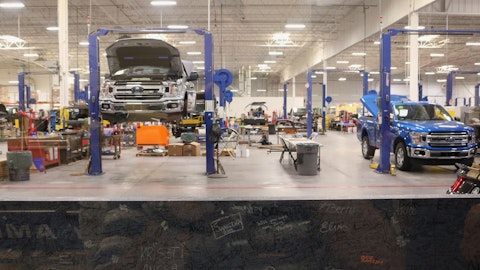Jeff Shepherd: Yeah, I’ll take the second part of that question first. In terms of inflation, particularly product inflation, we do think it’s going to be more of a first half versus a second half, so that’s the way we’ve sort of modeled it here internally. We haven’t broken out the contribution of gross margin and SG&A, specifically for the year in terms of the 140 to 180 basis point expansion, but we do believe that we’ll get margin contribution from both gross margin and SG&A. Overall, we think gross margin will likely contribute more, but we’re laser-focused on both growing our gross margin while controlling our cost base.
Christian Carlino: Thank you. That’s very helpful. Best of luck.
Jeff Shepherd: Thanks.
Operator: Thank you. Our next question for today comes from Elizabeth Suzuki from Bank of America. Elizabeth, your line is open. Please go ahead.
Elizabeth Suzuki: Great. Thank you. So regarding your distribution network and getting the right part to the customer at the right time. You talked about the Toronto DCs that were consolidated and that there’s more opportunity. So what percentage of your distribution network, do you think is due for an upgrade or consolidation/replacement at this point?
Tom Greco: Hey, good morning, Liz. Let me give you a bit of context on how we’re thinking about our longer-term strategy and growth. We feel very well positioned to execute the next generation of our go-to-market strategy. Our vision is really to leverage the entirety of our enterprise assets to provide a superior customer experience within Pro as we accelerate growth and profitability. I know all of you know that the DIFM business has a lower gross margin than the DIY business. We’re uniquely positioned to be able to grow top line sales from here and continue to improve our margins even though you’re growing the DIFM business faster. And that’s because we’ve got plenty of assets to compete out there. In the past, they just weren’t as connected as they were – sorry, as they are today.
We used to have four disparate supply chains or technology platforms. That’s all behind us. So to your direct question, we’re testing variations of this end-state vision now. We talked about Toronto. We’ve got all the enterprise assortment located into a single building. We think this has application much more broadly across the entire enterprise. We’ve got to still prove that out, but we feel really good about what’s happening in Toronto. And I think look for us to replicate that in markets across North America.
Elizabeth Suzuki: All right. Great. Thank you.
Operator: Thank you. Our next question comes from Bret Jordan of Jefferies. Bret, your line is now open. Please go ahead.
Bret Jordan: Hey. Good morning, guys.
Tom Greco : Good morning.
Jeff Shepherd: Good morning.
Bret Jordan: On the Pro performance, I guess, sort of relatively underperforming versus peers. Could you talk about, sort of, what you see as the major impact? I mean is it an availability issue? Is it, sort of slow traction on the private label program? And I guess are you seeing competition where IMC against Autopart International Worldpac, is there other sort of French competitors that are changing the environment? But if you could sort of lay out how you see the Pro business maybe trailing a little bit and what the factors are that would be great.
Tom Greco: Sure. I mean, we talked a little bit about our – the actions we’re taking, Brett, on the call, and we expect Pro to accelerate through the year. Really three elements to the plan. I mean we’ve done a lot of work to identify what’s driving the underperformance, and there’s really a couple of things. First of all, the availability opportunity that we talked about on the last call, we’ve made targeted inventory investments to improve that. And that spans both high velocity SKUs, which we’re plusing up in both our stores and our distribution centers and in some cases, adding breadth and coverage to hubs and super hubs and in-market nodes. So first of all, inventory investments to improve availability is job one, that’s the biggest opportunity.





